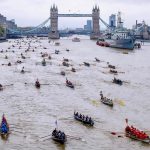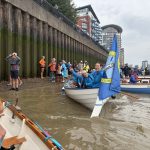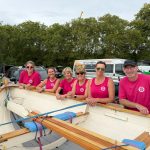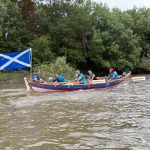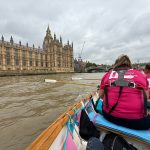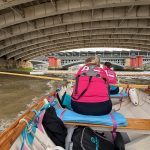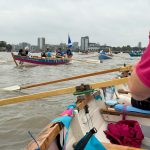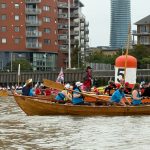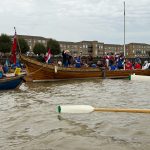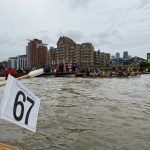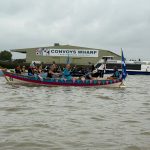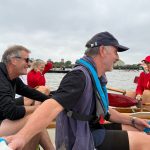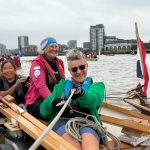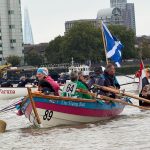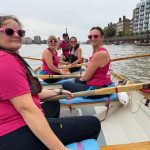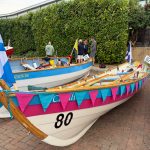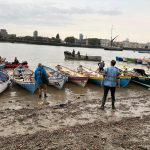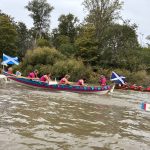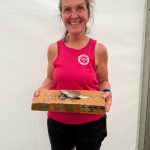The Great River Race 2025 – Wormit Takes on The World (Again)
Nobody could accuse the rowers – ‘Skiffies’ -of Wormit Boating Club of not being up for a challenge. Having over the last few years ventured as far afield as the Netherlands, the Tweed, Stranraer (for Skiffieworlds…twice), the Isles of Arran and Bute, as well as competing in myriad regattas and other fixtures the length and breadth of Scotland – Cromarty, North Berwick, Ullapool, Lochs Tummel and Tay, and Inchcolm Island, to name but a few, yet another endeavour recently captured the imagination of this happy – if slightly deranged – band.
The exact genesis of how this particular event popped into the Club’s programme remains a mystery (Lesley has been mentioned as a possible prime instigator, with Gail as a likely co-conspirator) as, in amongst all the other Club goings-on, The Great River Race became, as it were, a thing. ‘GRR’ for short is billed as ‘London’s River Marathon’ and is a spectacular, competitive race from Millwall in the east to Richmond in the west, travelling under no fewer than twenty-eight of London’s famous bridges. The race seemingly began back in 1988 with sixty-one boats crewed by a bunch of enthusiasts ranging from young scouts to hardened offshore rowing veterans coming from everything from rowing clubs, pubs, schools, boating societies and the armed forces, since which time it has grown the proverbial arms and legs to become the biggest and most prestigious event of its kind in Europe, with participants competing for 37 trophies. This year, around 300 crews took part, including from the Americas, the Antipodes, many European countries plus of course the Home Nations.
As plans firmed up, it looked like the Club would be able to muster the requisite six-person crews for two boats, the arcane requirements of The Company of Watermen and Lightermen of The River Thames requiring each boat to carry a passenger and coxswain, along with a flag of at least 3 x 2 feet. With the Club Committee onside, skiffs The Flying Boat and Catalina were earmarked for the long drive south and the rigours of a race expected to attract over 2,500 competitors in over 300 craft of all sizes, ranging from the sleek, no-nonsense Thames watermen’s cutters to sturdy whalers with a dozen rowers, from fast Cornish pilot gigs and Norfolk wherries to the swift and seaworthy Celtic and Pembrokeshire longboats, from elegant picnic boats and countless other classes of craft to the Queen of the Seas in the familiar shape of our own St Ayles skiffs. The only common factors apart from the aforementioned passengers and flags were that all the vessels competing were powered via fixed seat rowers. A fiendishly complicated handicap system ensures fair play and tests the seamanship and boat handling skills (and intellectual capacity) of coxes and crews alike; more on which in a moment.
Weeks of planning, form filling, briefings and preparations all came together on a bright September Wednesday, where following final practice by The Flying Boat crew to perfect their seamless mid-race changeover technique – not so much poetry in motion as ‘get that oar handle out of my ear’- boats were tied down, electrics connected up and tyres checked ahead of the epic 1,000 mile round trip to That London and back. With a cheery wave and a song in their hearts (in Sam’s case possibly ‘Don’t Rock The Boat, Baby’) our intrepid skiffies stepped into cars, climbed aboard campervans and clambered onto trains in the fervent hope that their next meeting would be on the banks of Old Father Thames, or at least in a pub somewhere within hailing distance of that mighty waterway. It is fair to say that while in general everybody enjoyed an uneventful and comfortable journey south, for those who decided to let the train take the strain (other ‘70s advertising references are available), the decision to indulge themselves with the comparative comfort of travelling first class was not entirely as anticipated. While Heather sat in Miss Haversham-like splendid isolation, Ruth found herself elsewhere on the same train in company with a rabble of pampered pooches whose general demeanour and personal habits left a lot to be desired. ‘Not so much First Class as Best in Class’, Ruth was later heard to lament.
Moving swiftly forward, our Wormit warriors did indeed progressively regroup, ultimately finding themselves plus two skiffs riverside in Millwall, The Flying Boat already afloat having been safely rafted upriver from Richmond. As the start time approached, boats were rigged and decorated; Wormit’s skiffs looking resplendent in their colour-coded bunting and with saltires snapping in the surprisingly stiff breeze that had begun to make its presence felt from the west, in sharp contrast from the day before, where back in the Richmond paddock temperatures had reached an unexpected and unseasonal 28C. Once afloat, our crews made their way to the waiting area, coxes threading their boats through a maze of other vessels and finding temporary respite tied to the trailing lines of moored buoys thoughtfully provided for the purpose. At the appointed time, Catalina, coxed by Gabriel and with Heather, Jenny, Sam, Nicky and Audrey making up a characteristically fierce Wormit women’s crew, followed closely by The Flying Boat with Dai at the helm and with mixed veterans Gail, Alex, Ruth, Andy and Stuart comprising her seasoned crew, headed for the starting line. At 1049 hrs sharp (GMT, of course), with hands taped, jaws set and loins girded, our Skiffies struck out for Richmond, some three hours and 21.6 miles distant.
Sometimes in life, reality conspires to confound expectation as, for example, when the menu’s triple-fried artisan rosemary-seasoned potato wedges turn out to be, well, chips. For those in Wormit’s skiffs, surging at full tilt up the Thames in the midst of a vast and colourful flotilla, sinews straining and hearts pounding, sparing no quarter for those around them, for once reality plays ball. And then some. Indeed, were it possible to access the individual inner monologues of our skiffies at this very moment, as they pass into yet another Visit London vista - whether Tower Bridge, the Palace of Westminster, the London Eye, the National Theatre or Battersea power station - the consensus view would likely be ‘Well, THIS is an absolute BLAST!’ All around is a melee of competing boats, jockeying for advantage as the next spectator-bedecked bridge approaches and the available leeway seems to diminish with alarming speed. The gig on Flying Boat’s port beam would appear not to have read the bit in the (dauntingly comprehensive) race rules about ‘no overtaking under bridges’, and up ahead a scout-powered tub has decided to heave-to mid-channel. And all the while the marshals’ powerboats and police launches are charging about demonstrating that, in the hierarchy of the hard-to-herd, rowing boats trump cats every time. It’s like Canaletto’s bustling Grand Canal, only turned up to eleven. And with RIBs. Avoiding numerous inventive-collision opportunities, both Wormit skiffs more than hold their own, Flying Boat’s crew successfully putting into practice their change-over routine with successive coxes keeping things on a mostly even keel. Eventually the tourist landmarks and high rises of central London give way to exclusive riverside apartments, water meadows and the kind of bucolic scenery to warm the heart of Jerome K. Jerome. Or Toad.
As the final few miles slip under our skiffs’ keels, the gap between The Flying Boat and Catalina, holding the advantage for most of the last two hours or so, begins to narrow, and briefly they are locked in a two-boat battle, each taking turns to nose ahead of the other. Finally, the veterans prevail – perhaps in part a consequence of their onboard musical chairs (‘Discuss’), and with her crew relinquishing their last vestiges of energy The Flying Boat sweeps across the finish mere minutes ahead of Catalina. With both boats safely recovered, with practiced deftness, onto their respective trailers, that, it seems, is that. Our trusty skiffies retire to an extensive and thronging refreshment area in search of well-earned hydration, ice cream and more substantial sustenance; given what they charge for 99s and burgers in London the spirit of Dick Turpin appears to be alive and well. There is, however, one more highlight yet to enjoy when, above the general hubbub of a thousand excited and increasingly well-lubricated rowers, amongst the various trophy winners’ announcements over the PA a familiar name is heard. ‘Did they just say ‘Wormit’?’ asks Jenny. ‘Do you know, I rather think they did’, replies Nicky, or maybe it’s rather more of a ‘Waaaaaahh!!!’. Either way, the big fat red cherry on top of an already plump and toothsome cake is Wormit’s women winning their class in GRR. In the ensuing bedlam it is a matter of record that ‘Wormit! Wormit! Wormit!’ (repeat ad infinitum until exhausted), a familiar refrain in the world of the St Ayles Skiff, has become one too in the respective worlds of Cornish pilot gigs, Celtic longboats etc etc. Quite the moment. Quite the crew. Quite emotional, truth be told.
Warmest congratulations are owed to all those who completed GRR 2025 and, as ever, sincerest thanks go to everyone who played a part, whether preparing the skiffs, organising the transport, wading through the avalanche of GRR paperwork, or putting everything to bed afterwards. The Great River Race was yet another massive success in a year already replete with endeavour, challenge, fun and, as is central to the sporting ethos and comradeship that are the hallmarks of Wormit’s skiffies, a LOT of cake.
Dai John

